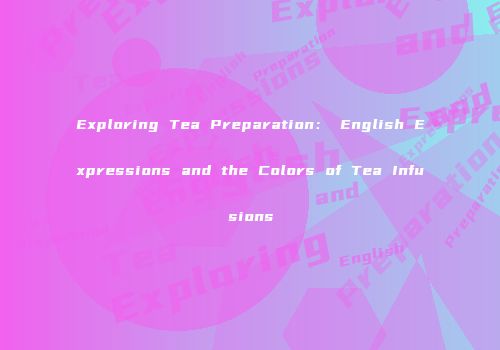In the realm of cultural exchange and culinary exploration, the art of tea preparation stands as a testament to the rich traditions and subtle nuances of various cultures. One such practice is the process of brewing tea, a ritual that varies in method but remains a universal symbol of relaxation and hospitality. This article delves into the English expressions used to describe the tea-making process and provides a guide to the colors of different tea infusions.
The English Expression of the Tea Brewing Process
To begin, the process of brewing tea can be succinctly and elegantly conveyed in English. Here's a step-by-step guide:
1. Boil water. This is the foundational step in preparing tea, ensuring the water is at the optimal temperature for extracting the flavors from the tea leaves.
2. Warm the teapot. Pre-warming the teapot helps maintain the temperature of the water and prevents the tea from cooling too quickly.
3. Place the tea leaves in the teapot. The choice of tea leaves can vary widely, from delicate green to robust black, each with its unique flavor profile.
4. Pour hot water into the teapot. The water should be poured over the tea leaves, allowing the heat to activate the flavors and aromas.
5. Steep the tea for minutes. The steeping time varies depending on the type of tea, with some requiring a shorter steep and others a longer infusion.

6. Pour the tea into a cup. Once the tea has steeped to the desired strength, it is transferred to a cup, ready to be enjoyed.
7. Enjoy your tea. The final step is to savor the tea, appreciating its taste and the experience it brings.
The Colors of Different Tea Infusions
The color of tea is not only a visual appeal but also an indicator of its quality and type. Here's a breakdown of the colors associated with various types of tea:
- Green tea (绿茶) typically presents a light, shallow green hue.
- Black tea (红茶) is known for its deep red color, a rich and robust shade that reflects its full-bodied flavor.
- Oolong tea (乌龙茶) can range from a light yellow to a deep amber, showcasing its complex flavor profile.
- White tea (白茶) has a light yellow color, reflecting its delicate and subtle taste.
- Pu-erh tea (普洱茶) often displays a deep red or brown color, indicative of its unique fermentation process.
By understanding these English expressions and the colors of different tea infusions, one can not only engage in the conversation about tea but also appreciate the artistry behind each cup. Whether you are a seasoned tea connoisseur or a curious beginner, this guide serves as a valuable resource for navigating the world of tea preparation and appreciation.
郑重声明:
以上内容均源自于网络,内容仅用于个人学习、研究或者公益分享,非商业用途,如若侵犯到您的权益,请联系删除,客服QQ:841144146








相关阅读
Exploring Tea: A Comprehensive Guide to Understanding Tea in English
2025-06-15 01:44:35The Warmth of Red Tea A Comforting Sensation
2025-08-05 00:58:08Exploring Chinese Tea Culture: A Guide to English Tea Art Performance and Sichuan Tea Traditions
2025-07-21 02:16:11Reasons to Collect Black Tea A Guide in English
2025-06-23 06:47:59品尝百年名茶的价格和特点「百年精典传奇品质tea茶价格」
2025-07-06 03:21:27